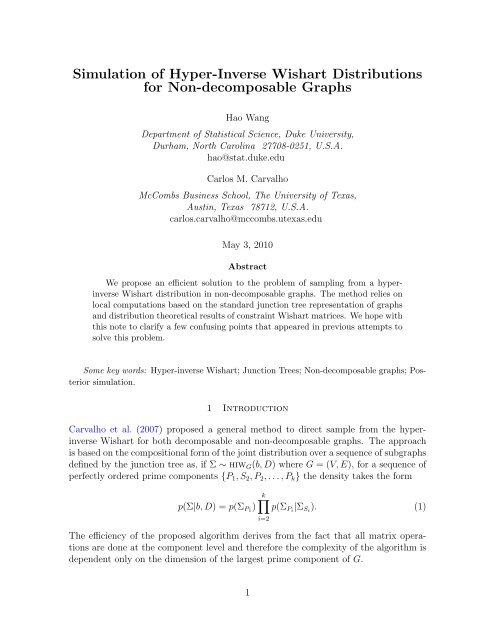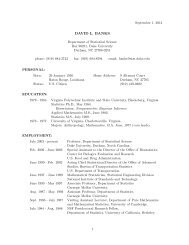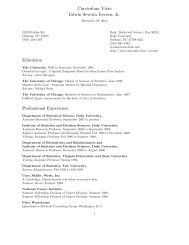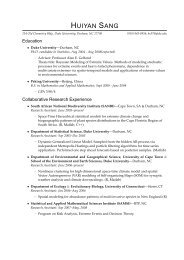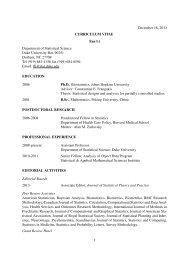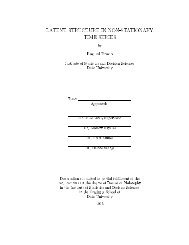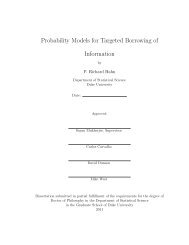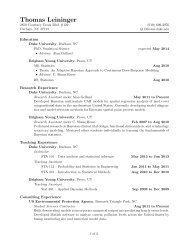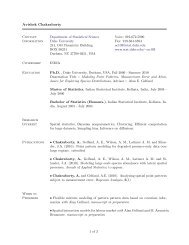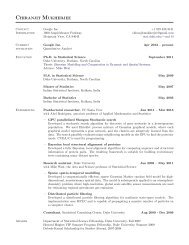Simulation of Hyper-Inverse Wishart Distributions for Non ...
Simulation of Hyper-Inverse Wishart Distributions for Non ...
Simulation of Hyper-Inverse Wishart Distributions for Non ...
You also want an ePaper? Increase the reach of your titles
YUMPU automatically turns print PDFs into web optimized ePapers that Google loves.
<strong>Simulation</strong> <strong>of</strong> <strong>Hyper</strong>-<strong>Inverse</strong> <strong>Wishart</strong> <strong>Distributions</strong><br />
<strong>for</strong> <strong>Non</strong>-decomposable Graphs<br />
Hao Wang<br />
Department <strong>of</strong> Statistical Science, Duke University,<br />
Durham, North Carolina 27708-0251, U.S.A.<br />
hao@stat.duke.edu<br />
Carlos M. Carvalho<br />
McCombs Business School, The University <strong>of</strong> Texas,<br />
Austin, Texas 78712, U.S.A.<br />
carlos.carvalho@mccombs.utexas.edu<br />
May 3, 2010<br />
Abstract<br />
We propose an efficient solution to the problem <strong>of</strong> sampling from a hyperinverse<br />
<strong>Wishart</strong> distribution in non-decomposable graphs. The method relies on<br />
local computations based on the standard junction tree representation <strong>of</strong> graphs<br />
and distribution theoretical results <strong>of</strong> constraint <strong>Wishart</strong> matrices. We hope with<br />
this note to clarify a few confusing points that appeared in previous attempts to<br />
solve this problem.<br />
Some key words: <strong>Hyper</strong>-inverse <strong>Wishart</strong>; Junction Trees; <strong>Non</strong>-decomposable graphs; Posterior<br />
simulation.<br />
1 Introduction<br />
Carvalho et al. (2007) proposed a general method to direct sample from the hyperinverse<br />
<strong>Wishart</strong> <strong>for</strong> both decomposable and non-decomposable graphs. The approach<br />
is based on the compositional <strong>for</strong>m <strong>of</strong> the joint distribution over a sequence <strong>of</strong> subgraphs<br />
defined by the junction tree as, if Σ ∼ hiw G (b, D) where G = (V, E), <strong>for</strong> a sequence <strong>of</strong><br />
perfectly ordered prime components {P 1 , S 2 , P 2 , . . . , P k } the density takes the <strong>for</strong>m<br />
p(Σ|b, D) = p(Σ P1 )<br />
k∏<br />
p(Σ Pi |Σ Si ). (1)<br />
The efficiency <strong>of</strong> the proposed algorithm derives from the fact that all matrix operations<br />
are done at the component level and there<strong>for</strong>e the complexity <strong>of</strong> the algorithm is<br />
dependent only on the dimension <strong>of</strong> the largest prime component <strong>of</strong> G.<br />
i=2<br />
1
In decomposable graphs their methodology follows directly from basic conditioning<br />
results <strong>of</strong> normals and <strong>Wishart</strong> distributions and it works perfectly. For nondecomposable<br />
graphs, however, they used the general distributional theory <strong>for</strong> the<br />
Cholesky decomposition <strong>of</strong> a hyper-inverse <strong>Wishart</strong> defined by Atay-Kayis & Massam<br />
(2005) in conjunction with their decomposition idea. We were able to identify two<br />
problems in this approach and are now able to propose a solution to it.<br />
For clarity <strong>of</strong> presentation we assume from this point <strong>for</strong>ward that G = (V, E) can<br />
be decomposed into two prime components and one separator {P 1 , S 2 , P 2 }. Assume<br />
further that the subgraph G P1 is complete and G P2 is not. This implies no loss <strong>of</strong><br />
generality as the proposed sampling process can be repeated down the junction tree in<br />
the presence <strong>of</strong> both complete and incomplete additional components.<br />
2 Sampling in a single non-decomposable prime component<br />
Let us start by focusing on sampling from the marginal distribution <strong>of</strong> the p × p covariance<br />
matrix Σ P2 ∼ hiw P2 (b, D P2 ). Remember that G P2 is a non-decomposable subgraph<br />
<strong>of</strong> G.<br />
Define K = Σ −1<br />
P 2<br />
so that K ∼ W G (b, D P2 ), a G-<strong>Wishart</strong> distribution with density<br />
p(K | G) ∝ |K| (b−2)/2 exp<br />
{<br />
− 1 }<br />
2 tr(KD P 2<br />
) 1 {K∈M + (G)}. (2)<br />
Write D −1<br />
P 2<br />
= T ′ T and K = Φ ′ Φ as Cholesky decompositions and define Ψ = ΦT −1 .<br />
Following the nomenclature <strong>of</strong> Atay-Kayis & Massam (2005), the free elements <strong>of</strong> Φ are<br />
those φ ij such that (i, j) is an edge in P 2 . From Theorem 1 and Eq. (38) <strong>of</strong> Atay-Kayis<br />
& Massam (2005), these free elements have density defined by<br />
p[ψ11, 2 · · · , ψpp, 2 {ψ ij } (i,j)∈E ] ∝ exp{− 1<br />
i
i. Sample Ψ following the Step 1 and 2 in Section 4.3 <strong>of</strong> Atay-Kayis & Massam<br />
(2005), and u ∼ U[0, 1].<br />
{<br />
}<br />
∑<br />
ii. Check whether u < exp − 1 2 (i,j)/∈E ψij<br />
2 . If this holds, accept Ψ as a sample<br />
i
4 Example<br />
We consider one simulated example that involves a two prime component non-decomposable<br />
graph G in Figure 1. The simulation method was applied to generate 5000 samples from<br />
the hyper-inverse <strong>Wishart</strong> distribution hiw G (203, D) where<br />
⎛<br />
D =<br />
⎜<br />
⎝<br />
35.93 0.73 4.68 1.77 0.87 4.35 6.20<br />
0.73 30.88 4.47 1.87 -0.39 2.30 2.05<br />
4.68 4.47 19.31 2.60 -0.89 0.29 1.57<br />
1.77 1.87 2.60 14.78 1.58 0.31 0.14<br />
0.87 -0.39 -0.89 1.58 18.03 2.91 1.48<br />
4.35 2.30 0.29 0.31 2.91 9.85 6.21<br />
6.20 2.05 1.57 0.14 1.48 6.21 9.55<br />
⎞<br />
.<br />
⎟<br />
⎠<br />
Figure 1: The underlying non-decomposable graph in the simulated example. The prime<br />
components and separators are P 1 = {1, 2, 3, 7}, S 2 = {3, 7}, and P 2 = {3, 4, 5, 6, 7}<br />
To demonstrate the efficacy <strong>of</strong> the our sampler, we first compute the theoretically<br />
exact value <strong>of</strong> E(Σ E | D, d, G), where Σ E denotes the free elements <strong>of</strong> Σ. The Corollary<br />
2 <strong>of</strong> Roverato (2002) implies that this expectation can be calculated as<br />
E(Σ E | D, d, G) = D E /(d − 2).<br />
The theoretically exact value and the Monte Carlo estimate based the sample mean <strong>of</strong><br />
the 5000 simulated covariance matrices are<br />
⎛<br />
⎞<br />
0.1787 0.0036 0.0233 · · · 0.0309<br />
0.0036 0.1536 0.0223 · · · 0.0102<br />
0.0233 0.0223 0.0961 0.0130 · · 0.0078<br />
· · 0.0130 0.0735 0.0078 · ·<br />
⎜<br />
⎝ · · · 0.0078 0.0897 0.0145 · ⎟<br />
⎠<br />
· · · · 0.0145 0.0490 0.0309<br />
0.0309 0.0102 0.0078 · · 0.0309 0.0475<br />
and<br />
⎛<br />
⎜<br />
⎝<br />
0.1790 0.0038 0.0234 · · · 0.0308<br />
0.0038 0.1536 0.0222 · · · 0.0101<br />
0.0234 0.0222 0.0962 0.0130 · · 0.0078<br />
· · 0.0130 0.0737 0.0078 · ·<br />
· · · 0.0078 0.0897 0.0146 ·<br />
· · · · 0.0146 0.0490 0.0309<br />
0.0308 0.0101 0.0078 · · 0.0309 0.0475<br />
4<br />
⎞<br />
,<br />
⎟<br />
⎠
espectively, where · denotes non-free elements to highlight structure.<br />
The mean and median number <strong>of</strong> samples required to accept one sample in the<br />
rejection sampling <strong>of</strong> Step (ii) in Section 2 is 1.35 and 1 respectively.<br />
5 Final Remarks<br />
We have identified and fixed two mistakes involving the sampling <strong>of</strong> hyper-inverse<br />
<strong>Wishart</strong> random variables conditional on non-decomposable graphical models as proposed<br />
by Atay-Kayis & Massam (2005) and Carvalho et al. (2007). Their ideas are<br />
still used in our approach and it now clear that direct samples can be obtained in a<br />
computationally efficient way by using the junction tree <strong>of</strong> a graph. Upon publication<br />
<strong>of</strong> this note, a R-package <strong>for</strong> sampling from general hyper-inverse <strong>Wishart</strong> distributions<br />
will be available at the author’s website.<br />
References<br />
Atay-Kayis, A. & Massam, H. (2005). The marginal likelihood <strong>for</strong> decomposable<br />
and non-decomposable graphical Gaussian models. Biometrika 92, 317–35.<br />
Carvalho, C., Massam, H. & West, M. (2007). <strong>Simulation</strong> <strong>of</strong> hyper-inverse wishart<br />
distributions in graphical models. Biometrika 94, 647–659.<br />
Roverato, A. (2002). <strong>Hyper</strong>-inverse <strong>Wishart</strong> distribution <strong>for</strong> non-decomposable<br />
graphs and its application to Bayesian inference <strong>for</strong> Gaussian graphical models. Scandinavian<br />
Journal <strong>of</strong> Statistics 29, 391–411.<br />
5


